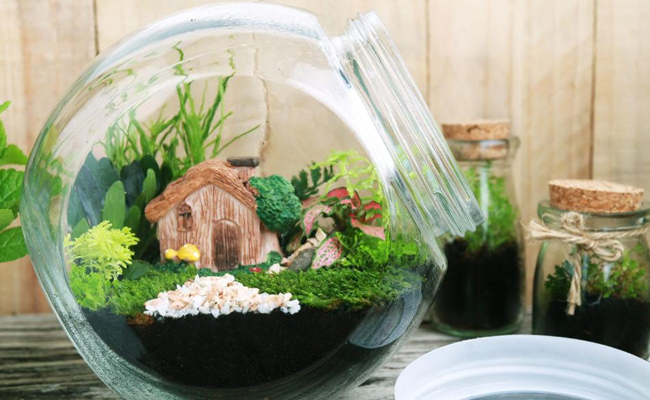Terrariums are small, self-contained ecosystems that can support plants and animals even if you don’t have much of a green thumb. Plants like tropical ferns, mosses, selaginella, peperomia, cryptanthus, and air plants do well in these environments because of the high humidity and low light levels.
Making your own little planet is easier than you think; all you need are some stones, some horticultural charcoal, and some potting soil layered in a glass jar.
Pick a Jar or a Box

As a first step, pick a sturdy container. We utilised cheap, widely available kitchen canisters because they have tight-fitting lids that trap the condensation plants need to grow. It’s important to remember, though, that not every container can be turned into a terrarium.
If you want your plants to thrive, you need keep them in a humid environment. Look around your house for interesting containers, such as glass canning jars, clear soup tureens, and empty bottles. Be sure that everything you pick is made of clear, pristine glass. “Coloured glass will block the sunlight your plants need to thrive.”
Creating a Terrarium
After deciding on a container, you can begin constructing your terrarium. Avoid clumsily inserting the structure when laying the pebble drainage base. Use a pastry bag without a tip to evenly distribute fine dirt or gravel throughout your terrarium.
- Put down a 1-inch layer of pebbles or gravel as a drainage basis.
- Sprinkle a little bit of gardening charcoal on top.
- Planting medium should be added.
- Make sure none of the plants’ leaves, petals, or stems are touching the glass by nestling them securely into the dirt and covering the roots.
- You can embellish it with figurines and oddly shaped rocks if you wish.
Tips for Keeping Your Terrarium Healthy
Although terrariums are simple to construct, they do require some basic maintenance to preserve the health of the plants within. Display the mini ecosystems throughout your home with care, and make sure they get enough water and light.
Water
Overwatering your plants is the worst thing you can do for them, so be cautious while watering them. Just spray the contents twice with water and seal the jar, taking care that no water collects in the base.
Condensation forms on the inside of terrariums because they function like miniature greenhouses. Too much condensation can be avoided by reducing the terrarium’s lighting or by leaving the lid off for two hours.
Light
Most terrariums thrive under a south-facing window or another location that provides indirect sunlight. Never put your terrarium where the afternoon sun will beat down on the foliage like a windowsill.
Humidity
Moist air is ideal for terrariums. Humidity is trapped and your plants thrive when the terrarium is closed.
So, if you need to use a container but don’t have a lid, you’ll need to get creative: placing a glass plate on top of a terrarium in the absence of a lid. Alternative: “Or if it’s a narrow-necked bottle, use a lightbulb to block the opening and create extra humidity.”
Cleaning the Terrarium Pot:
Once water spots or algae growth appear on the interior, which usually happens once a week, give it a good cleaning. Makeshift tools, such as long-handled tweezers and scissors, are useful for getting into tight spaces, such as the corners of a container.
Get Rid of the Garbage
Using these implements, you may clean up the corners and crevices of your terrarium. Pick up dead leaves with long-handled tweezers and scissors, or trim leaves from the plant or the edge of the glass with chopsticks.
A wire hanger can be used in place of tweezers to access those difficult-to-reach areas. To keep what’s hidden from view, “use a wire hanger to make a little hook or loop to move leaves and plants out of the way.”
Cleaning the Jar
Floral wire can be used to attach a little piece of sponge to a solid object (a chopstick, wooden spoon, or even a piece of thin bamboo will do). You can clean the inside of your terrarium using the sponge.









































